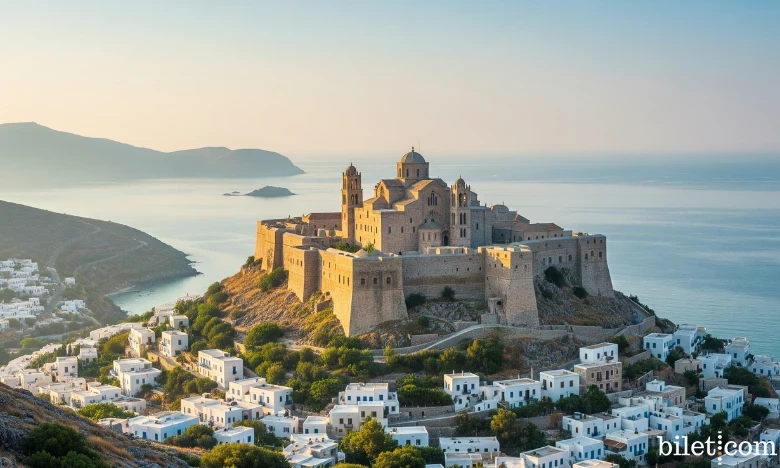Origin of the Name: "Patmos" and Ancient Connections
Although the exact origin of the name Patmos is unknown, there are several theories:Patmos (Πάτμος): According to one view, the name of the island comes from Mount Latmos in the Carian region, indicating that the first settlers of the island came from this region. Another interpretation is that the word may mean something like "a place covered with pine trees", but the current vegetation of the island does not fully support this theory.
Letois: It is known that the island was also called "Letois" in ancient times. This name is associated with the Titan Leto, the mother of the God Apollo and the Goddess Artemis, and indicates the existence of a temple dedicated to Artemis on the island in ancient times.
A Holy Island: St. John and the Birth of the Book of Revelation
The most important role of Patmos in world history is its direct connection with the Book of Revelation (Apocalypse), one of the sacred texts of Christianity.The Exile of St. John: St. John the Theologian/Evangelist, one of the twelve apostles of Jesus, was exiled to Patmos by the Roman Emperor Domitian around AD 95.
Cave of the Apocalypse (Cave of the Apocalypses): According to legend, St. John lived in a cave on the island during his exile and wrote down the revelations he received from God to his student Prochoros, creating the Book of Revelation. The triple cleft in the cave (symbolizing the voice of God, the Holy Trinity), the stone where St. John laid his head, and the rock indentation where he leaned his hand are visited by pilgrims today. This cave is considered one of the holiest places in the Christian world.
Patmos in the Stream of History: The Rise of Monasticism and Autonomy
The history of Patmos was shaped by the monastery founded during the Byzantine period, especially after the exile of St. John.Ancient and Roman Periods: It is known that there were settlements on the island in ancient times and that there was a temple of Artemis. During the Roman period, it was generally used as a place of exile due to its distance from its strategic location and its small structure.
Byzantine Period and Foundation of the Monastery: In 1088, by the decree of Byzantine Emperor Alexios I Komnenos, the Monk Hosios Christodoulos (St. Christodoulos) began to build a magnificent monastery on the island dedicated to St. John. Over time, this monastery became not only a religious center but also an important center of education, culture and art. It is famous for the priceless manuscripts and icons in its library.
Ottoman Period and Privileges: Patmos, like many of the Dodecanese islands, came under Ottoman rule. However, due to the religious importance of the monastery and the island, the Ottoman sultans granted the island extensive privileges. Thanks to tax exemptions and a degree of autonomy, Patmos continued to exist as a "monastic state" with the settlement of Chora developing around the monastery, and became an important Greek Orthodox center in the Aegean. During this period, the island also developed commercially and culturally.
Italian Domination and Accession to Greece: Patmos, which came under Italian rule together with the Dodecanese Islands in 1912, was annexed to Greece in 1948 after the Second World War.
UNESCO World Heritage Sites and the Pearls of Patmos Waiting to Be Discovered
Patmos is a UNESCO World Heritage Site with its historic centre consisting of three main parts:Monastery of St. John: Rising like a castle on one of the highest hills of the island, this monastery fascinates with its thick walls, courtyards, churches, chapels, library full of priceless manuscripts and museum containing rare examples of Byzantine art.
Cave of the Apocalypse: Located between Monastir and Skala, this sacred cave is where the Book of Revelation is believed to have been written and hosts thousands of pilgrims every year.
Chora (Hora): Chora, which developed around the monastery, is one of the most beautiful examples of traditional Aegean architecture with its narrow labyrinthine streets, snow-white houses, arched passages and magnificent mansions. It fascinates with its calm atmosphere and monastery views.
Skala: The main port and liveliest settlement of the island, Skala is the center of modern life with its restaurants, cafes, shops and hotels.
Beaches: Patmos has quiet beaches, far from the crowded tourism. Grikos Bay (sheltered and picturesque), Kampos (organized and popular), Lambi (famous for its colorful pebbles) and Psili Ammos (fine sand) are some of the island's delightful beaches.
Windmills of Chora: Restored traditional windmills on the hills of Chora provide a window into the island's past and provide stunning views.
How about planning a trip to Patmos to breathe in the mystical atmosphere of this holy island, follow the footsteps of St. John and find peace in the serenity of this special corner of the Aegean?







